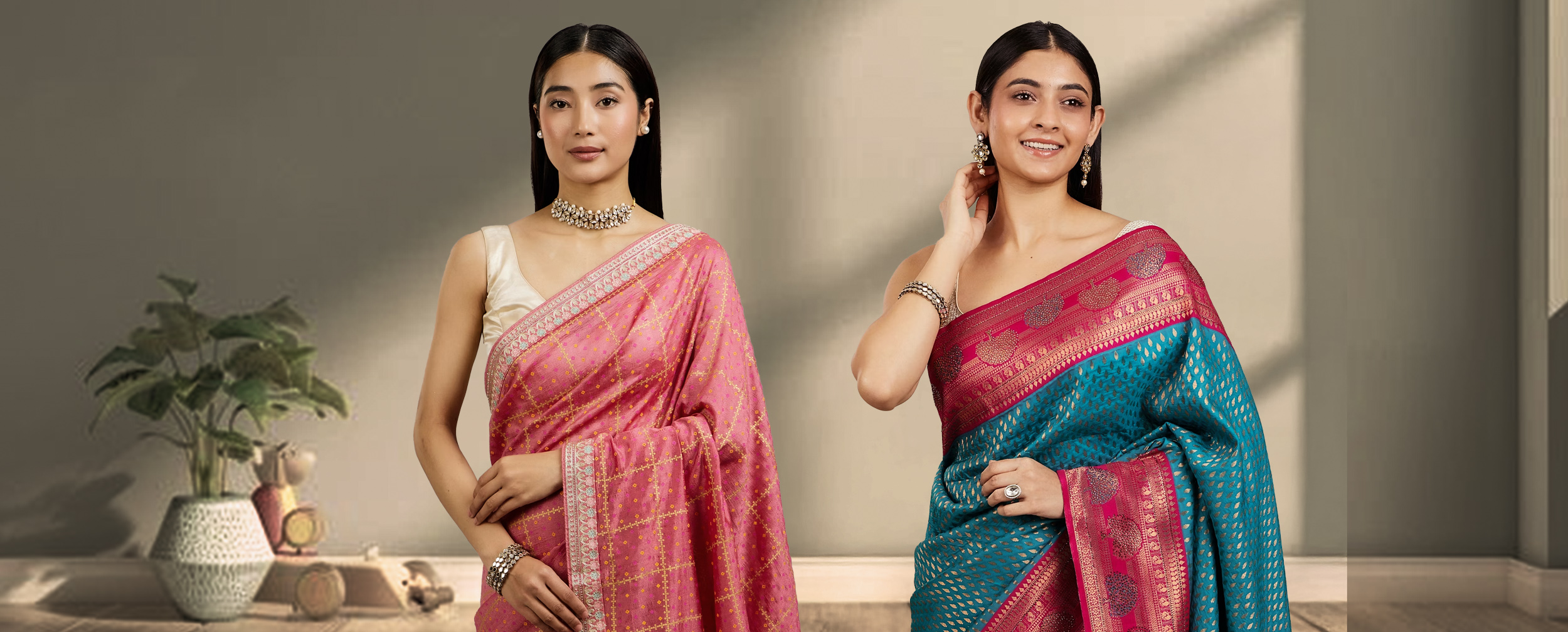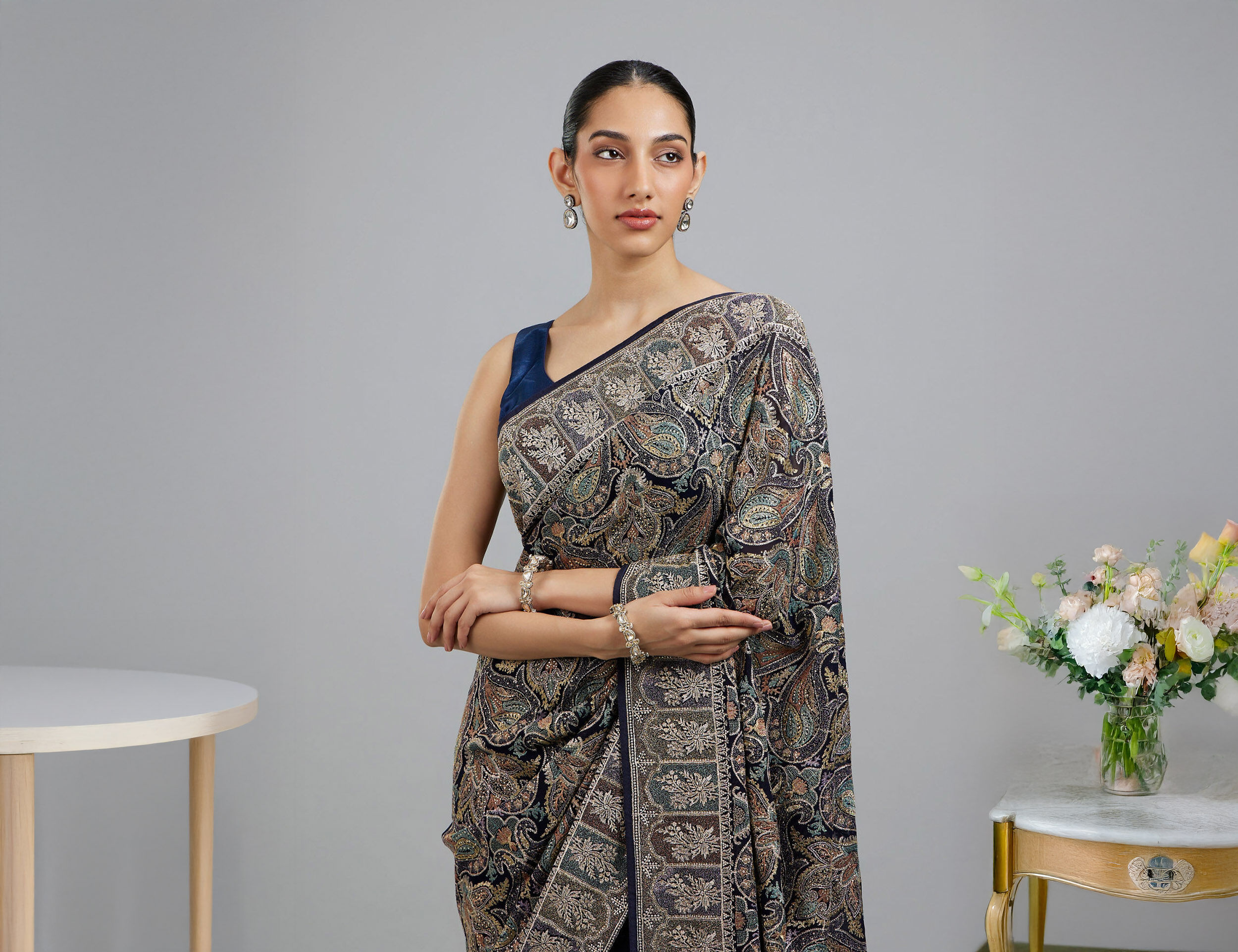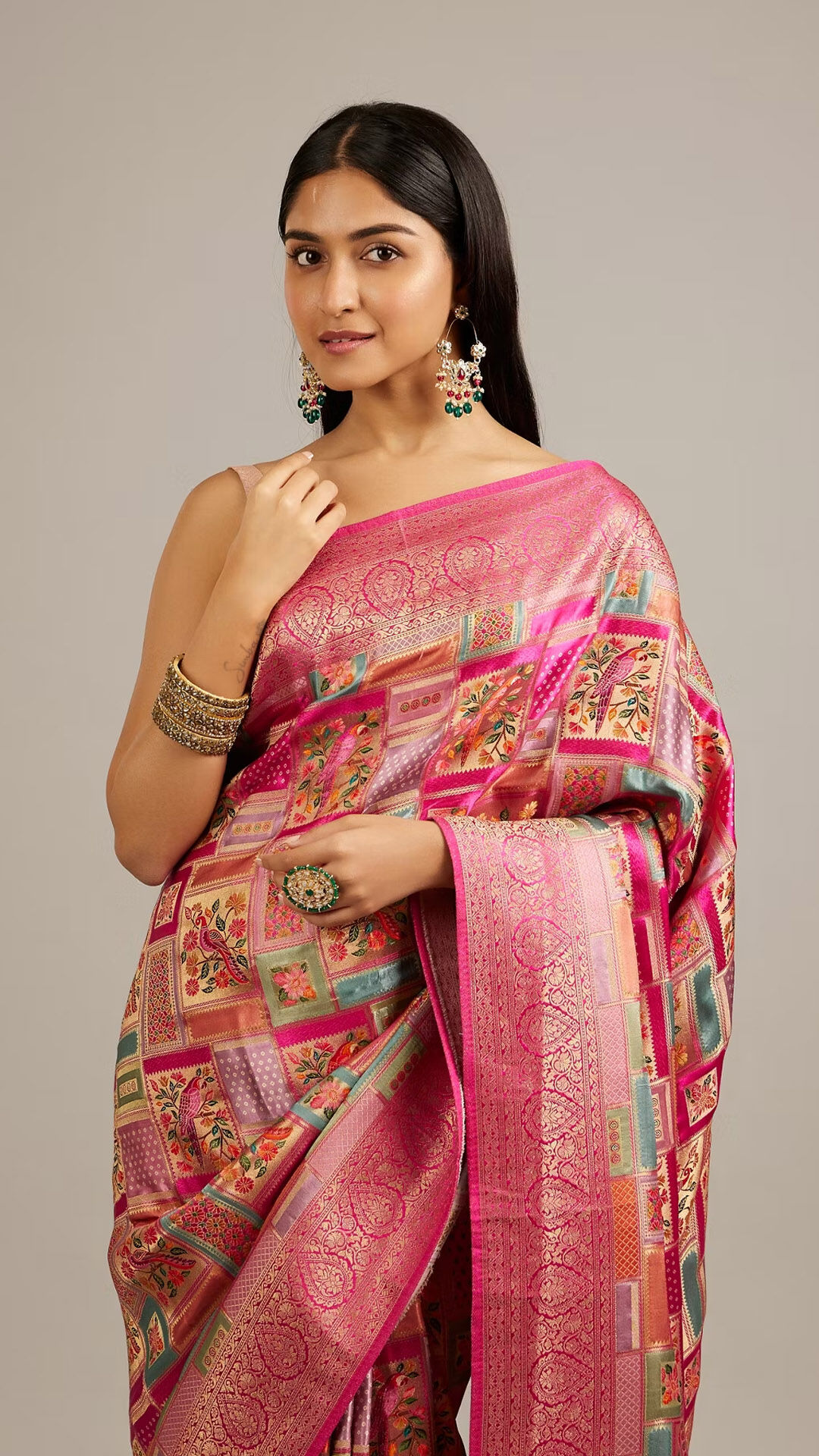STORIES BY MANYAVAR & MOHEY

Lifestyle
Match Your Moments: Selecting The Right Zari Work Saree Design For Each Wedding Function
Date 18 June 2025 Reading time: 7-10 mins
The glimmer of zari threads catching the light as a bride walks toward her future. The whispers of "kitni soni lag rahi hai" from admiring guests. The feeling of heritage wrapped around you in six yards of sheer magic. A zari work saree design isn't just an outfit—it's a canvas telling your wedding story through timeless motifs that have adorned Indian brides for generations.
But which motifs suit which function? Is a peacock perfect for the sangeet—or better saved for the wedding itself? Should reception regal zari motif sarees feature delicate florals or bold geometrics? What's the difference between a Banarasi zari saree with temple motifs versus one with bel patterns?
This comprehensive guide will walk you through choosing the perfect saree design of zari work motifs for every wedding event, ensuring you shine at each function without ever looking out of place or overdressed. Let's decode the language of zari, one motif at a time!
Understanding Zari Saree Motifs
Zari isn't just decorative—it's deeply symbolic. The peacock represents beauty and immortality, the lotus signifies purity, while the mango (paisley) motif symbolises fertility and life. These weren't random choices by our ancestors; each saree design element carried wishes and blessings for the bride's future.
History and Significance of Zari Saree Motifs
The story of zari begins with the Persian word "zar", meaning "gold"—a fitting origin for something so precious. Zari work saree design techniques flourished during the Mughal era, transforming from royal court treasures to beloved bridal heirlooms across India.
The craftsmanship behind a heavy zari work saree involves thousands of hours of meticulous labour. Artisans from Banaras, Kanchipuram, and Surat have preserved these techniques for centuries, passing down the art of creating perfect zari motifs from generation to generation.
Today's wedding saree types with zari work blend these ancient techniques with contemporary sensibilities, offering brides both timeless charm and modern relevance. The zari craftsmanship saree design you choose connects you to this rich legacy while expressing your personal style.
Popular Zari Saree Styles for Weddings
When it comes to wedding sarees, certain zari work saree design styles have stood the test of time.
Different Types of Zari Saree Motifs
From floral and paisley to temple spires, zari motifs reflect the depth of India’s cultural landscape. Let's explore the most popular rich handwoven zari saree motifs:
- Floral Motifs: From delicate jasmine buds to full-blown lotus blooms, floral Zari work saree designs bring natural beauty to your drape. These range from realistic botanical patterns to stylised interpretations.
- Peacock Motifs: A favourite in Banarasi zari saree designs, the peacock represents beauty and grace. These motifs can be elaborate showstoppers or subtle accents in the pallav.
- Geometric Patterns: Clean lines, symmetrical arrangements, and mathematical precision characterise geometric saree designs. These include jaal (net) patterns, checks, and temple designs.
- Paisley (Buta/Ambi): The teardrop-shaped mango motif appears in countless zari work saree design variations. From tiny bootis scattered across the fabric to large ambi patterns dominating the pallav.
- Temple Motifs: Inspired by South Indian temple architecture, these zari work designs feature distinctive triangular patterns representing temple spires.
- Nature-Inspired Motifs: Beyond florals, nature-inspired saree designs include vines, leaves, trees, rivers, and celestial elements like stars and moons.
- Animal Motifs: Elephants, horses, peacocks, and mythical creatures appear in many heavy zari work saree designs, particularly those with royal heritage.
Factors to Consider When Choosing Zari Saree Motifs for Weddings
Selecting the perfect zari work saree design for each wedding event requires thoughtful consideration of several factors:
- Event Formality: The main ceremony demands more elaborate zari craftsmanship saree designs than pre-wedding functions. Consider how formal each event is when choosing motif complexity.
- Time of Day: Daytime events pair beautifully with zari work designs of saree featuring smaller, scattered motifs that catch natural light. Evening functions call for bolder, more dramatic patterns that shine under artificial lighting.
- Personal Style: Are you drawn to minimalist elegance or maximalist drama? Your personal aesthetic should guide your saree design choices.
- Body Type: Larger motifs draw attention to where they're placed, while all-over smaller patterns create a more balanced look. Choose zari work saree designs that highlight your best features.
- Regional Traditions: Different communities have traditional preferences for wedding saree types. Southern brides often favour temple motifs, while North Indian celebrations might feature more Mughal-inspired designs.
- Colour Palette: The background colour of your Banarasi saree affects how prominently the zari motifs stand out. Gold zari pops against jewel tones, while silver zari complements pastels beautifully.
- Weight Considerations: A heavy zari work saree with dense motifs can be quite weighty. Consider your comfort for events where you'll be standing or moving for hours.
Matching Zari Saree Motifs with Different Wedding Saree Types
Different wedding saree types lend themselves to specific zari work saree design motifs:
- Banarasi Zari Sarees: The quintessential bridal choice, these sarees excel with intricate jaal (net) patterns and elaborate pallav designs featuring peacocks, flowers, and vines. The dense zari woven saree design creates a royal aura perfect for main ceremonies.
- Kanjivaram Sarees: South Indian silk treasures that pair beautifully with temple motifs, checked patterns, and large border designs. The contrast between the regal zari motif saree and the vivid silk background creates a striking visual impact.
- Organza Sarees: These lightweight beauties showcase delicate, scattered motifs that allow the transparency of the fabric to shine through. Small floral bootis and fine border zari work saree patterns complement the airy nature of beautiful organza sarees.
- Silk Sarees: Classic silk provides the perfect canvas for medium to heavy zari work saree designs. The natural sheen of silk enhances the glow of zari threads. Discover beautiful silk sarees with zari work for your special day.
- Party Wear Sarees: Contemporary saree designs with modern motifs and innovative placements work beautifully for reception and cocktail events.
- Chiffon Sarees: The flowing lightness of chiffon pairs perfectly with minimal, strategic intricate zari embroidery saree elements—perhaps a stunning border or pallav with some scattered motifs.
Choosing the Right Zari Saree Motifs for Wedding Events
The art of selecting the perfect zari work saree design for each wedding function comes down to understanding the mood and meaning of each event.
How to Style Zari Saree Motifs for Different Wedding Events
Different wedding functions call for different zari work saree design approaches:
- Main Wedding Ceremony: This is where the heavy zari work saree truly shines! Opt for elaborate all-over jaal patterns with a dramatically designed pallav. Banarasi zari sarees with peacock motifs, temple designs, or royal procession scenes make perfect ceremony wear.
- Reception: Slightly more contemporary zari woven saree designs work beautifully here. Consider geometric patterns, abstract motifs, or modernised floral designs that feel fresh yet festive. Rose gold or copper zari adds a contemporary twist to reception outfits.
- Sangeet: Vibrant, celebratory regal zari motif sarees suit this musical evening. Look for dynamic motifs like dancing figures, musical instruments, or rhythmic geometric patterns.
- Mehendi: Light, playful zari work saree designs with small scattered motifs work perfectly for this fun pre-wedding event. Tiny peacocks, paisleys, or floral bootis create a festive but not overwhelming look.
- Haldi: Since turmeric staining is a concern, minimal zari work saree patterns are a practical choice. Consider sarees with just zari borders or small corner motifs that can be draped strategically away from haldi splashes.
- Engagement: Sophisticated zari craftsmanship sarees that balance tradition with modernity suit this formal announcement. Geometric patterns, contemporary florals, or abstract designs in Banarasi sarees make excellent choices.
Choosing Your Best Zari Saree
The perfect zari work saree design does more than just adorn you—it tells your story, honours your heritage, and becomes part of your wedding memories. From the heavy zari-work saree you choose for your pheras to the lighter designs for pre-wedding celebrations, each motif carries meaning and beauty.
As you select your wedding saree collection, remember that the best choices balance tradition with personal style. Whether you're drawn to the timeless appeal of a Banarasi saree with classic motifs or the contemporary charm of innovative zari-woven saree designs, Mohey offers options that honour both heritage and modern sensibilities.
Ready to find your perfect wedding zari work saree design? Explore Mohey's stunning zari saree collection and discover pieces that will become treasured heirlooms, carrying the golden threads of your wedding story into your future.







